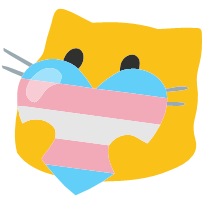traaaaaaannnnnnnnnns
Welcome to /c/traaaaaaannnnnnnnnns, an anti-capitalist meme community for transgender and gender diverse people.
-
Please follow the Hexbear Code of Conduct
-
Selfies are not permitted for the personal safety of users.
-
No personal identifying information may be posted or commented.
-
Stay on topic (trans/gender stuff).
-
Bring a trans friend!
-
Any image post that gets 200 upvotes with "banner" or "rule 6" in the title becomes the new banner.
-
Posts about dysphoria/trauma/transphobia should be NSFW tagged for community health purposes.
-
When made outside of NSFW tagged posts, comments about dysphoria/traumatic/transphobic material should be spoiler tagged.
-
Arguing in favor of transmedicalism is unacceptable. This is an inclusive and intersectional community.
-
While this is mostly a meme community, we allow most trans related posts as we grow the trans community on the fediverse.
If you need your neopronouns added to the list, please contact the site admins.
Remember to report rulebreaking posts, don't assume someone else has already done it!
Matrix Group Chat:
Suggested Matrix Client: Cinny
https://matrix.to/#/#tracha:chapo.chat
WEBRINGS:
🏳️⚧️ Transmasculine Pride Ring 🏳️⚧️
⬅️ Left 🏳️⚧️🏳️🌈 Be Crime Do Gay Webring 🏳️⚧️🏳️🌈 Right ➡️

view the rest of the comments


Calling "they" gender neutral doesn't really describe how it's actually used. The issue is that the word "they" is being used in three different ways:
As a pronoun for enbies: This is pretty straightforward. "They" is the go-to pronoun for enbies owning to the fact that it's not a neopronoun, not "he/she," and not "it."
As a pronoun to describe a person of indeterminate gender: A good example is someone on the other side of a door where you can only see their silhouette or a human player in a multiplayer game.
As a filler pronoun that points to a noun where the noun's gender is irrelevant or nonexistent: This one is the hardest to explain. If I have a sentence "Everyone has skeletons in their closets," the "their" points to "everyone," but "everyone" doesn't have a particular gender associated with it by virtue of "everyone" meaning, well, everyone, so every person of every gender. This is often used for hypotheticals like "The Communist disdains to conceal their views and aims" where the "Communist" is a hypothetical Communist and not a real person with a real gender. As a hypothetical person, "Communist" doesn't have a gender, so the "their" which points to "Communist" doesn't have gender either.
Calling "they" gender neutral is a poor way of describing how it's being used, and I would argue that "they" has never been truly gender neutral because if it were actually gender neutral, then "they" could be used for all people of all genders with no one feeling gender dysphoria or feeling like they have been misgendered which is obviously untrue. At best, "they" is gender indeterminate. Actual gender neutral pronouns are indefinite pronouns like "someone" or "somebody," pronouns that convey no gender. "It" functions closer to an actual gender neutral pronoun in the sense that everyone (except for various enbies who do use it/its) feels equally dehumanized but in a "you're calling me an inanimate object" way instead of a misgendering way.
Those assholes insisting on calling you they/them are just saying you don't pass as a cis woman and are hiding behind "uh aktually they is gender neutral so I'm not misgendering you" when "they" isn't even gender neutral. I think the three uses need to be properly delineated, each with their own pronouns. Maybe it should be they/their for (1), one/ones for (2), and it/its for (3). You get introduced as a one until you specify your pronouns in which case no one has any excuse to hide behind since one/ones is no longer applicable when the person actually says what pronouns they use. I think he/she/they-one should mimic tu-vous in the sense that "one" is used for complete strangers where you're not expected to know their pronouns while "he/she/they" are used for people you are more familiar with. Obviously, the social context where a pronoun circle takes place is one where you move from "one" to "he/she/they."
I just realized my post is only tangentially related to what you wrote. I guess I got carried away.
This is an incredible explanation, thank you. I don't have any thoughts or questions, but know I really appreciate it.